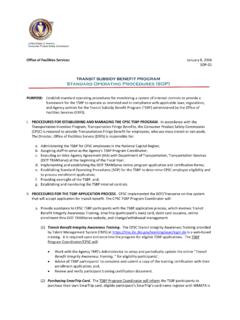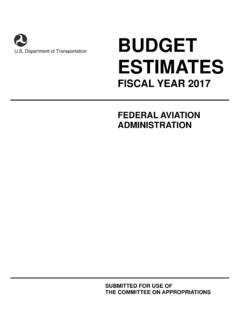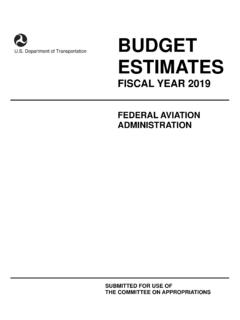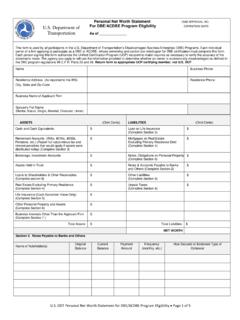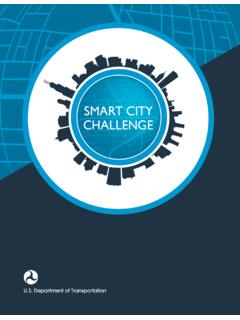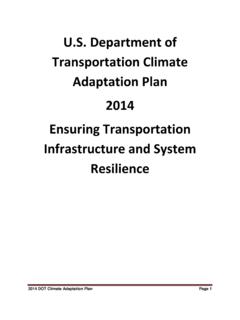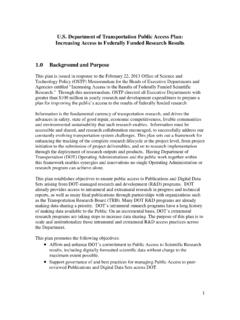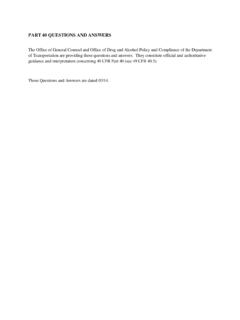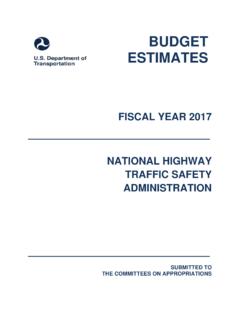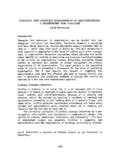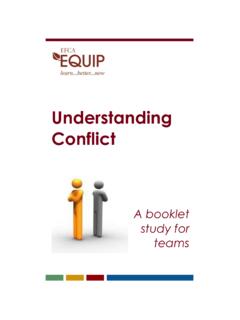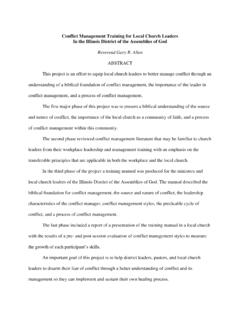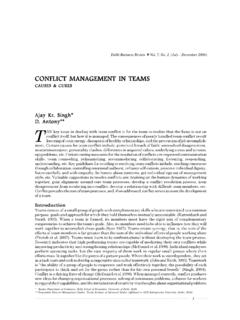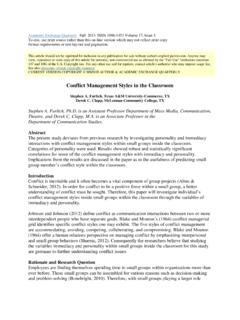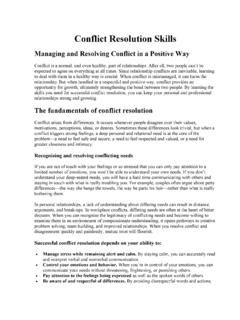Transcription of Managing Workplace Conflict: Understanding the …
1 Managing Workplace Conflict: Understanding the Options 2 CONTENTS INTRODUCTION .. 2 INFORMAL APPROACHES Alternative Dispute Resolution (ADR) .. 3 Employee Assistance Program (EAP) .. 5 FORMAL ROCEDURES Administrative Grievances .. 6 Negotiated Grievances .. 7 Equal Employment Opportunity (EEO) Complaints .. 10 Merit Systems Protection Board (MSPB) Appeals .. 11 Office of Special Counsel (OSC) Complaints .. 12 INTRODUCTION 3 All organizations have nothing is the least advisable course. All organizations have conflict. We can respond to conflict with choices that lead to destructive outcomes.
2 These include escalating battles that lead to hurt and unsafe feelings or suppressed frustration that eats away at employees comfort. We can also respond to conflict in a manner that leads to constructive outcomes. While many employees would like a constructive resolution to conflict, we often do not know how to achieve such a resolution, and so may not believe that it is possible. Frequently when we experience conflict, we can work things out by ourselves, quickly and satisfactorily. However, when a person feels a need for assistance in order to attempt to reach a constructive solution, the Federal Government and the Department of Transportation (DOT) offer a variety of kinds of assistance.
3 This Guide is intended to help you choose an option best suited to your situation. Formal avenues are available to employees, such as the grievance and EEO complaint processes. Like the court system, these are rights-based and end with a decision-maker determining the final outcome. Each approach has its own timeframes, procedures, and decision-making structure. The demands on an employee s finances, time, and emotions, as well as the demands on the work environment, vary as well. Informal avenues are also available. Alternative Dispute Resolution (ADR) leaves the resolution of conflict to the persons who have the conflict.
4 ADR can help employees improve communication, build relationships, and understand another person s perspective. The availability of ADR before, during, or in place of the formal dispute resolution avenues provides employees a more personal option for addressing their concerns. ADR is an interest-based option because it focuses on the interests of the parties. Employees are encouraged to review this Guide. Should you face a Workplace conflict, a call to the referenced contacts or a visit to the listed websites may provide you with some critical information. Protections against reprisal exist for employees who elect to pursue these options.
5 Please note that this Guide is informational only and does not replace or take precedence over any laws, regulations or policies that govern the listed processes. In most instances of conflict, doing nothing is the least advisable course of action. By seeking to address concerns early and choosing an appropriate avenue, you can increase the chances of resolving your situation in the most timely and effective manner. INFORMAL APPROACHES ALTERNATIVE DISPUTE RESOLUTION (ADR) What is ADR? 4 ADR is a voluntary alternative to, and not a replacement for, formal dispute resolution systems such as grievances, discrimination complaints, and appeals.
6 Unlike more formal processes, where management and employees are placed in a contest to determine a winner and a loser, ADR provides an arena where individuals may thoroughly examine all the matters related to Workplace concerns and develop solutions that are acceptable to all parties. In ADR, participants can generally arrive at resolutions much more quickly than decisions can be issued in the formal process, and resolutions are designed by the participants rather than by an external party..resolutions are designed by the participants rather than by an external party. ADR consist of a variety of approaches and techniques for early intervention and dispute resolution that include mediation, conciliation, facilitation, early neutral evaluation, ombuds, and others.
7 Each ADR technique provides a non-adversarial setting where employees can openly discuss issues and examine possible solutions with the assistance of a neutral third party. Who may use ADR? Any employee, including managers, temporary appointees, professionals, and support and administrative staff, may ask to participate in ADR and may request that other involved individuals participate. ADR is appropriate for interpersonal disputes, possible disciplinary or performance-related actions, as well as concerns about violations of regulations or discrimination. ADR is available to an employee who is experiencing conflict with a co-worker, or with a supervisor, and may be requested whether or not a complaint, grievance, or personnel actions has been initiated over the matter.
8 Employees maintain the right to pursue those more formal avenues as long as they meet the required deadlines. Employees maintain the right to pursue more formal avenues as long as they meet the required deadlines. How does ADR work? 5 DOT encourages all employees to pursue available ADR options at the earliest possible time in order to minimize the disruptions and stress that often accompany conflict. Any employee can start an ADR process by contacting the agency s ADR programs listed below. If an employee is already in one of the formal dispute resolution systems, an opportunity to participate in ADR may be offered as a part of that system.
9 DOT encourages all employees to pursue available ADR options at the earliest possible Although there are a number of different ADR techniques, mediation is the one used most frequently at DOT. In mediation, a trained neutral mediator usually begins the session with all the participants present by explaining the procedures and ground rules that will be used. The participants are then invited to present the issues important to them in their own words. They may voice their concerns and say what they are hoping for, while the mediator provides structure, balance, and fairness throughout the discussion. The mediator may meet separately with each participant to discuss matters further and to develop possible options for resolution.
10 Throughout the mediation process, the participants listen to each other s concerns and try to focus on the kind of future they can build together. Although an agreed upon resolution between the parties is the primary goal, mediation is often considered successful if a better Understanding or relationship between the participants is achieved..mediation is often considered successful if a better Understanding or relationship between the participants is achieved. In addition to mediation, other ADR techniques are increasingly becoming available at DOT. All of these processes emphasize voluntariness, neutrality, confidentiality as permitted by law, and the ability of the parties to determine their own futures.
